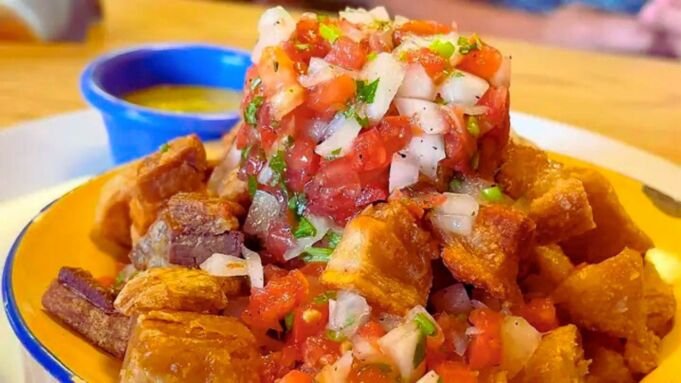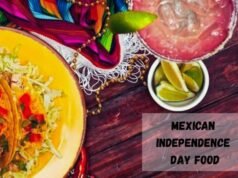Yuca Con Chicharron is a traditional dish from Honduras and El Salvador made by pairing boiled yucca root with lemon juice and cabbage and garnishing it with crispy, deep-fried pork chicharrón and a spicy tomato sauce. Typically served as a side dish, it complements a variety of main courses such as soups, tamales, or roasted meats, but it can also stand alone as an appetizer.
In the rich tapestry of Central American cuisine, “Yuca con Chicharrón” emerges as a quintessential dish, revered for its delightful combination of textures and flavors. This simple yet flavorful meal, featuring cassava and fried pork, captures the essence of the region’s culinary traditions, offering a taste that is both rustic and deeply satisfying.
What Is Yuca Con Chicharron?
Yuca con chicharrón is a beloved dish in El Salvador and Honduras. It consists of yuca (also known as manioc) accompanied by raw cabbage dressed in lemon, topped with crispy pork skins (chicharrones), and drizzled with a spicy sauce made from tomatoes, mojo (a blend of oil, garlic, onion, and spices like oregano), and either bitter orange or lemon juice.
This dish features chunks of yuca, either boiled or fried, combined with fresh cabbage and served alongside crunchy fried pork skin. Yuca con chicharrón typically complements other dishes such as soups, tamales, or carneada (grilled meat).
Fried yuca, derived from the cassava or manioc root, is a starchy tuber similar in taste and texture to potatoes, though its preparation involves steaming before frying to achieve a golden hue. Rich in calcium and vitamin C, fried yuca offers a sweeter and firmer alternative to potatoes. While distinctly different from French fries, both share comparable culinary uses.
Read More: Flor de Izote
Historical Background
Yuca, also known as cassava, has been a staple in the diets of Central American indigenous peoples long before the arrival of Europeans. Its ability to thrive in diverse climates and its versatility in various dishes have made it a regional favorite. The introduction of pigs by Spanish colonizers brought chicharrón, or fried pork, into the local culinary scene, creating a fusion that would become a cultural hallmark.
Ingredients and Variations
The primary ingredients of “Yuca con Chicharrón” include boiled or fried yuca and crispy chicharrón. It is often served with curtido, a tangy pickled cabbage slaw, and salsa roja, enhancing the dish’s vibrant flavors and colors. While the basic components remain the same, variations exist from one country to another, reflecting local tastes and culinary techniques.
How To Prepare Yuca Con Chicharron?
Yuca con chicharrón, a staple dish in Honduras and El Salvador, bears resemblance to Nicaragua’s vigorón in its basic preparation. The yuca is boiled with a pinch of salt until tender. Chimol, a fresh salsa, is made by dicing tomatoes, onions, and spicy green chili, then seasoning them with salt, pepper, and either vinegar or lemon juice.
The cabbage is finely shredded and cleansed either with hot or chlorinated water. The yuca is served warm or hot, layered on a plate starting with the yuca, topped with cabbage, chimol, and finally, chicharrón. Alternatively, this dish can be prepared with pork leg cooked in tomato sauce, with or without chicharrón.
In Guatemala, particularly in the eastern regions like Chiquimula and Zacapa, yuca with chicharrón is also immensely popular and considered a local delicacy.
Related: Turkish Foods
Yuca Con Chicharron Price
The price of “Yuca con Chicharrón” can vary widely depending on the location and setting in which it is purchased. In Central America, where the dish is a staple, it is generally quite affordable, often found at local markets and street food stalls for a few dollars per serving.
In the United States and other countries, the price might be higher, particularly in restaurants specializing in Latin American cuisine, where a single plate can range from $10 to $20 depending on the restaurant’s location and the quality of ingredients used. The cost of homemade Yuca con Chicharrón will depend largely on the local price of yuca and pork, which can also vary by region and availability.
Nutritional Value
Yuca is a carbohydrate-rich tuber with a good supply of vitamin C and dietary fiber, offering energy and essential nutrients. Chicharrón, although high in protein, is also rich in fats, making “Yuca con Chicharrón” a hearty dish best enjoyed in moderation within a balanced diet.
READ: Lebanese Food
Cultural Significance and Modern Adaptations
“Yuca con Chicharrón” is more than just food; it is a cultural symbol, often served during festivals and family gatherings across Central America. This dish reflects the agricultural practices and historical influences that have shaped the region, playing a crucial role in culinary traditions and everyday life.
Modern chefs have embraced “Yuca con Chicharrón,” infusing it with new life through creative interpretations and fusion techniques. From gourmet versions incorporating fine dining elements to healthier adaptations using air-fried techniques, the dish continues to evolve while maintaining its cultural roots.
Conclusion
“Yuca con Chicharrón” stands as a testament to the enduring appeal of Central American culinary heritage, offering a blend of history, culture, and flavor that continues to captivate and comfort generations. Whether savored in its most traditional form or explored through modern adaptations, it remains a dish celebrated by all who taste it.
To Know More: Honduran Food
Frequently Asked Questions (FAQs) about the delicious Central American dish “Yuca con Chicharrón”:
What is Yuca con Chicharrón?
Yuca con Chicharrón is a popular dish in Central America, particularly in El Salvador and Honduras. It consists of boiled or fried yuca (cassava) served with crispy fried pork skins (chicharrón) and is typically accompanied by chimol (a fresh tomato salsa) or curtido (pickled cabbage).
What does yuca taste like?
Yuca, also known as cassava, has a starchy texture similar to potatoes but is slightly sweeter. When cooked, it becomes tender and absorbs flavors well, making it an excellent base for the rich, savory taste of chicharrón.
How do you prepare yuca for cooking?
Yuca should be peeled to remove the tough outer skin, then cut into pieces and boiled in salted water until tender. It can also be fried after boiling to add a crispy texture.
Is Yuca con Chicharrón healthy?
While yuca is a good source of carbohydrates and vitamin C, chicharrón is high in fat and calories. Therefore, Yuca con Chicharrón should be enjoyed in moderation as part of a balanced diet.
Can Yuca con Chicharrón be made vegetarian?
Yes, for a vegetarian version, you can substitute the pork chicharrón with crispy fried mushrooms or tofu. These alternatives provide a similar texture and rich flavor when seasoned well.
What are the best side dishes to serve with Yuca con Chicharrón?
Traditional sides include curtido (pickled cabbage salad) and chimol (tomato salsa). These add freshness and a slight acidity that balances the richness of the yuca and chicharrón.
Where can I find yuca to make this dish?
Yuca can be found in most Latin American grocery stores and some mainstream supermarkets in the international foods section. It is available both fresh and frozen.















